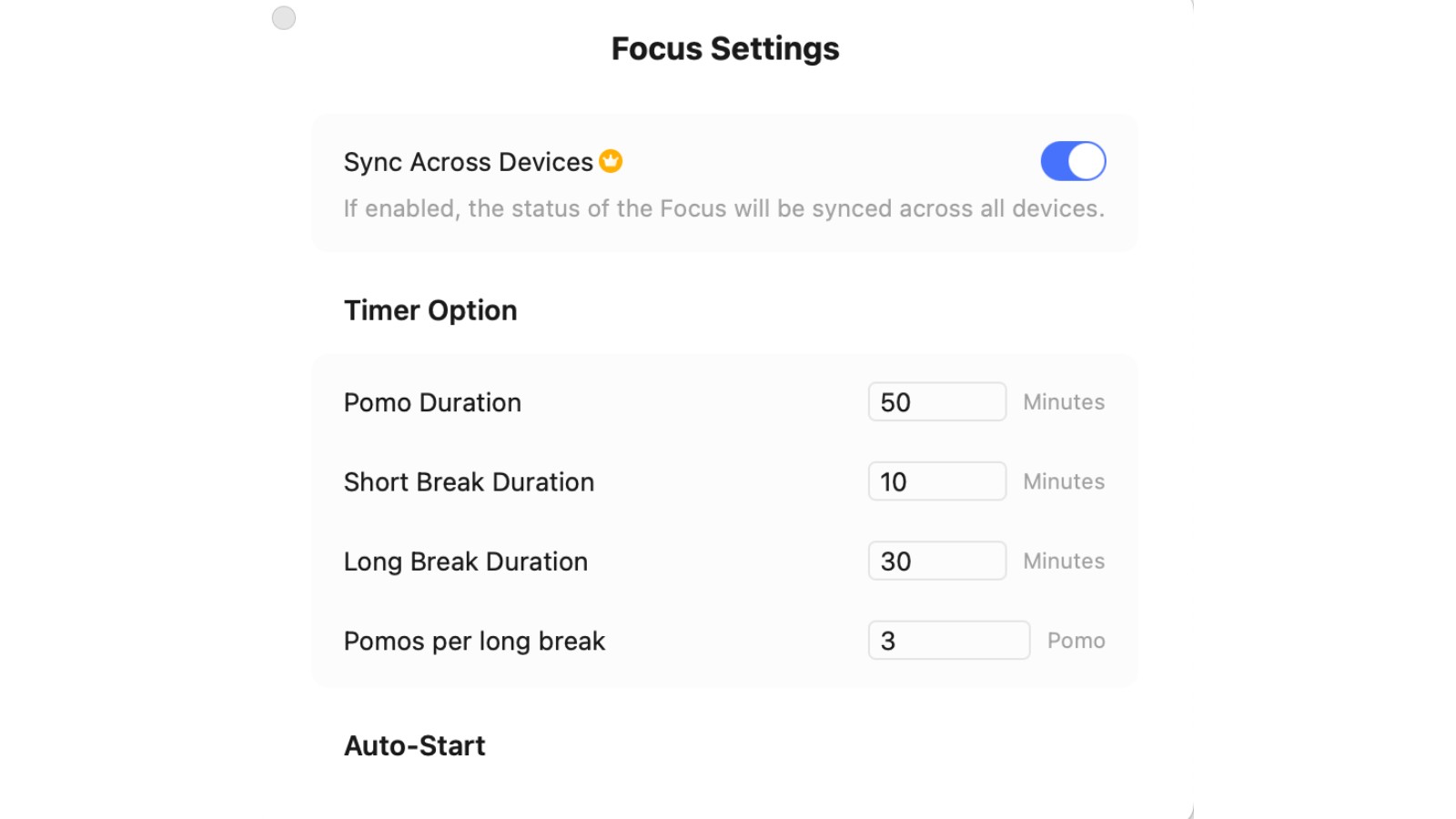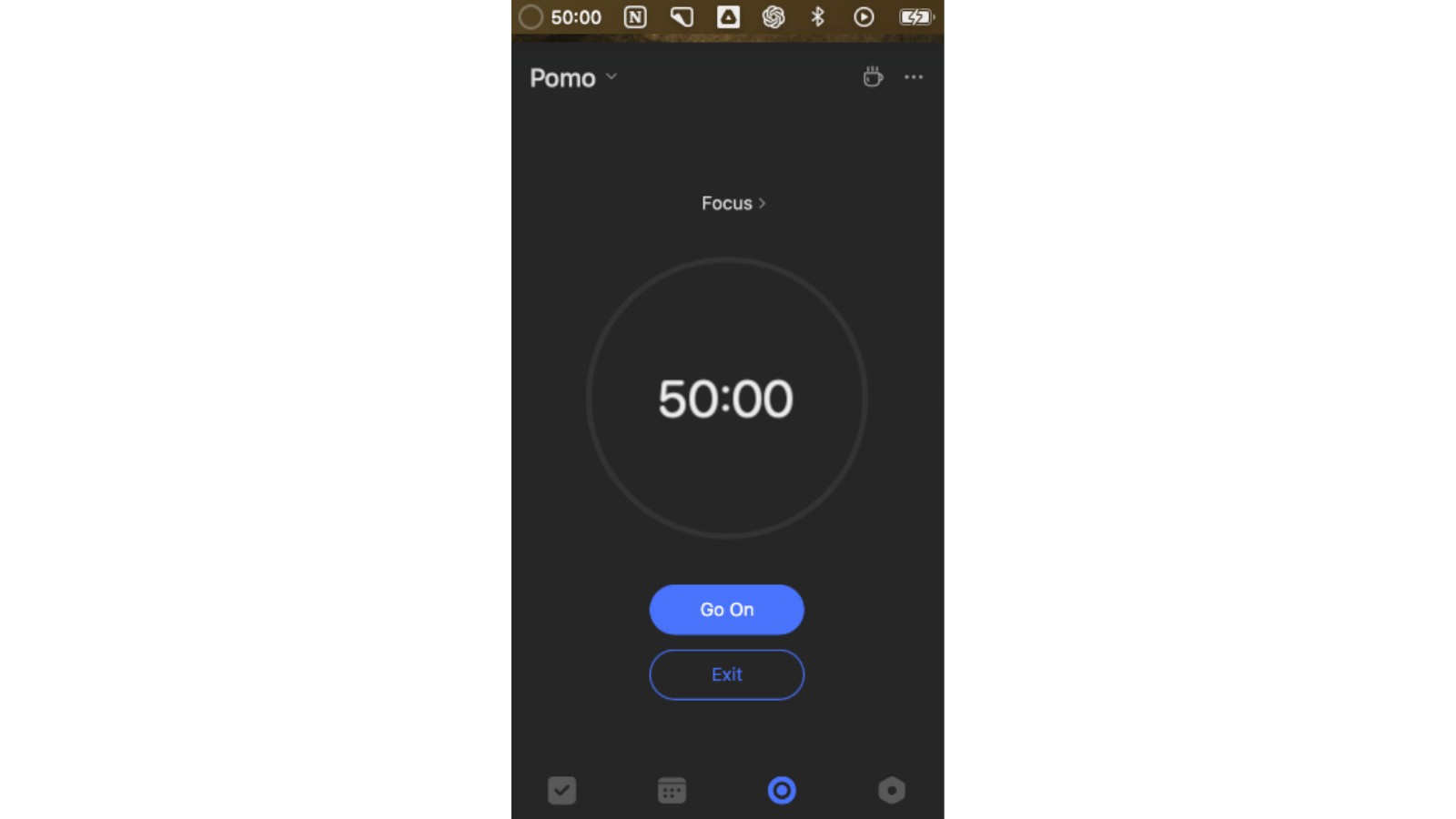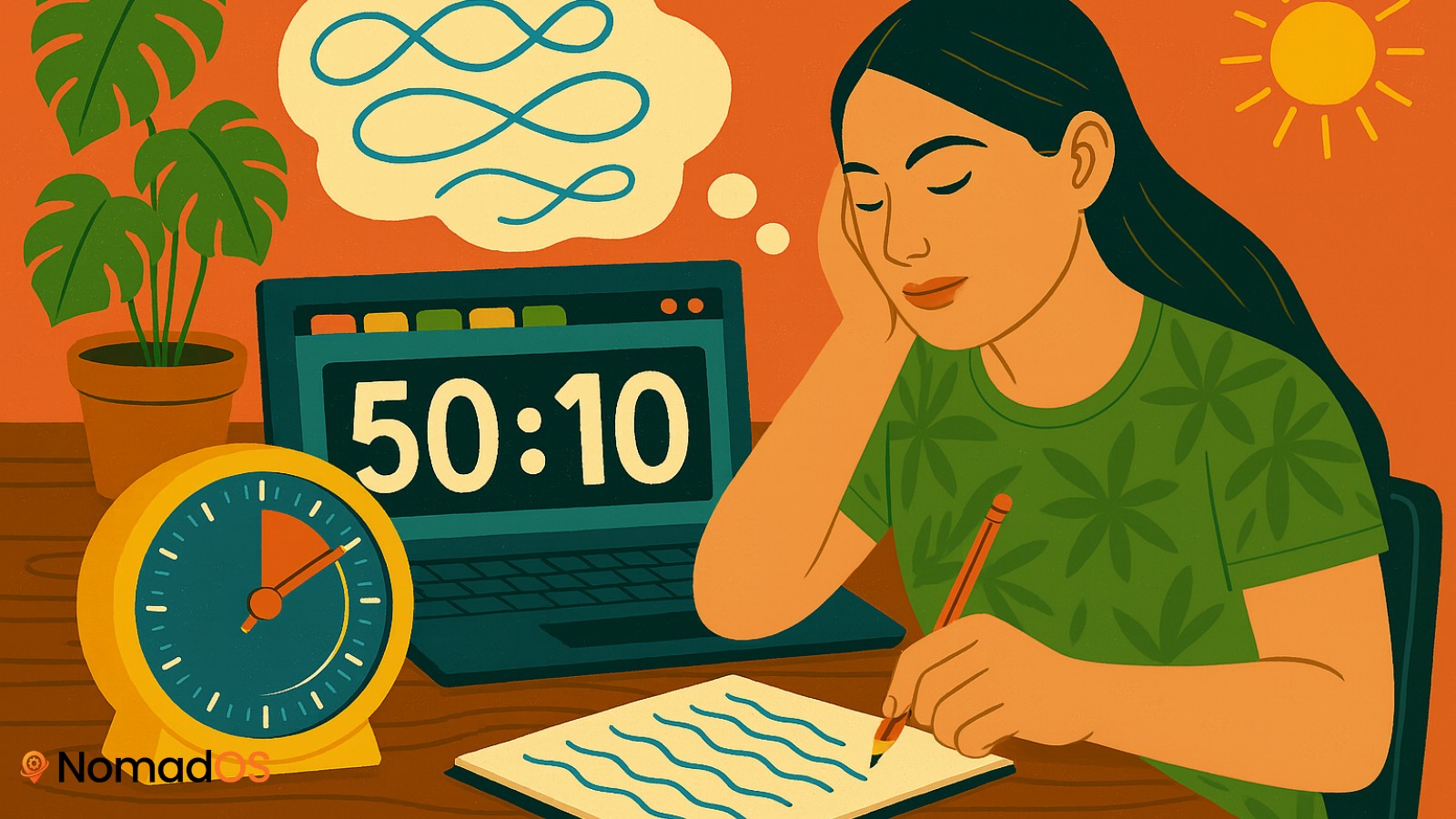For years, I collected productivity methods like souvenirs. The Pomodoro Technique with its 25-minute intervals. Time blocking. Deep work sessions. Getting Things Done. Each promised to be the key to unlocking my focus, and each worked for a while before I found myself back where I started.
After months of feeling like I wasn’t getting work done and losing motivation to sit at my laptop, I realized something fundamental was wrong with my approach.
The classic Pomodoro would interrupt my flow state right when I was hitting my stride. Longer focus blocks left me scattered and distracted after an hour. I was stuck between methods that were too short and too long.
Then everything changed during a coworking session at a local coffee shop.
How I Discovered the 50-10 Method
My friend said, “Let’s do some sprints. Fifty minutes of focused work, then ten minutes off.”
I’d never heard of this approach, but he set his timer and we dove in. When that first 50-minute block ended, I looked at my screen in disbelief.
I had completed more meaningful work in that single session than I typically managed in an entire morning of scattered effort.
That was my introduction to what I now know as the 50-10 rule, and it completely transformed how I approach work.
Later, I discovered that Adam Finan from the Digital Nomad Cafe podcast uses the same system, along with specific preparation techniques that I’ve since incorporated into my own routine.
Seeing multiple people succeed with this method convinced me it wasn’t just a lucky coincidence.
The beauty of the 50-10 approach is its flexibility. There’s no single “right” way to implement it. What matters is finding the version that works best for your brain, your work style, and your life circumstances.
The Evolution from Pomodoro to 50-10
The 50-10 method didn’t emerge in a vacuum. It evolved from Francesco Cirillo’s groundbreaking Pomodoro Technique, developed in the late 1980s, which popularized the concept of time-boxed work sessions followed by deliberate breaks.
Cirillo’s original framework used 25-minute work blocks with 5-minute breaks, a rhythm that revolutionized how millions of people think about focused work.
But as more people experimented with structured work-rest cycles, many discovered that 25 minutes felt too short for complex or immersive tasks.
The problem became clear: just as you hit your flow state around the 20-minute mark, the timer would buzz and pull you out of deep work.
You’d either ignore the break and work through multiple cycles, defeating the purpose of the structured rest, or take the break and spend valuable mental energy trying to regain your momentum.
The 50-10 variation emerged organically as people extended the work period to allow for deeper engagement while maintaining the principle of regular, restorative breaks.
Unlike the traditional Pomodoro, this longer format gives you enough time to move past the initial friction of starting a task and settle into sustained concentration.
It’s not revolutionary, it’s evolutionary. The same core principles that make Pomodoro effective, adjusted for how our brains actually sustain attention.
The Science Behind Why 50-10 Works
The theoretical foundation for the 50-10 method draws from chronobiology and cognitive research. Studies suggest that human attention naturally fluctuates in cycles, with many people able to sustain focused work for 50-90 minutes before needing a mental reset.
Research on micro-breaks supports the effectiveness of regular rest periods. A 2022 systematic review found that micro-breaks under 10 minutes generally improve well-being and reduce fatigue during work sessions.
The analysis showed that longer breaks within this category yield better performance results, making the 10-minute rest period in the 50-10 method particularly effective.
However, the science isn’t definitive about optimal work-rest ratios. Multiple studies have tested various patterns, including 50-minute work periods, with mixed results depending on the type of work and individual differences.
What’s consistent across research is that structured breaks help maintain cognitive performance over extended periods. Without these breaks, even with rest periods, cognitive fatigue accumulates throughout a full workday.
The key insight isn’t that 50-10 is scientifically proven as the optimal ratio for everyone.
It’s that this particular rhythm aligns well with natural attention patterns for many people, providing enough time to achieve deep focus without pushing past the point of diminishing returns.
My 50-10 System
After about a week of using this method, I developed a system that consistently delivers results. It’s built around two main blocks per day, each containing three 50-minute sprints.
Block One (Morning):
- Sprint 1: 50 minutes focused work
- Break: 10 minutes (no screens, physical movement)
- Sprint 2: 50 minutes focused work
- Break: 10 minutes
- Sprint 3: 50 minutes focused work
- Extended break: At least 30 minutes (often longer when I head to the gym, but depends on what I have planned)
Block Two (Afternoon):
- Same pattern: three 50-minute sprints with 10-minute breaks between the first two sessions
This gives me five hours of laser-focused work daily, which accomplishes more than 8-9 hours at the laptop filled with distractions and scattered multitasking.
The key is trying to plan for two blocks of three sprints each day, with that minimum 30-minute break between blocks, though I’m flexible when needed.
The Critical Break Protocol
The way you spend your 10-minute breaks determines whether this system succeeds or fails. When I read about Adam’s implementation, he mentioned not checking his phone during the short breaks, which made perfect sense to me so I implemented it right away.
Here’s what actually works:
No screens, period. Your brain needs genuine rest from visual stimulation and decision-making.
Get up and move away from your workspace. Physical movement helps reset your mental state and prevents the break from bleeding into work time.
Choose low-cognitive activities: stretching, walking, light exercise, washing dishes, tidying up, or brief meditation. Anything that gives your brain a complete break from thinking hard.
I’ll admit I sometimes fail at avoiding my phone, but more often than not I stick to it with no problems and it feels great knowing I haven’t checked it.
Sometimes I end up naturally doing other things and still not checking my phone after the block, rather than rushing to it straight away.
I keep a list of 5-minute and 10-minute activities posted near my workspace so I don’t waste break time deciding what to do.
Workspace Preparation
One of the most valuable additions to my 50-10 practice came from Adam’s approach to sprint preparation. Before starting each 50-minute block, I do a complete mind dump of all thoughts, tasks, and distractions onto paper.
Then comes the crucial step: I close every browser tab except the ones directly related to the work I’m about to do. No email, no Slack, no research tabs from yesterday. Just the specific tools and resources needed for the next 50 minutes.
This preparation eliminates the cognitive load of seeing unfinished tasks or interesting distractions calling for attention.
When your digital workspace matches your mental workspace, those 50 minutes become genuinely productive instead of just busy.
The mind dump serves another purpose. It captures all the random thoughts and ideas that would otherwise interrupt your focus mid-sprint.
Knowing everything is written down gives your brain permission to focus completely on the task at hand.
Common Mistakes and How to Avoid Them
After using this system consistently for a month and sharing it with friends, I’ve seen a few mistakes derail people’s success with the 50-10 method.
Mistake #1: Treating breaks as suggestions. When you’re in flow, it’s tempting to keep working past the 50-minute mark. This defeats the entire purpose. The breaks aren’t rewards for good work, they’re essential maintenance for sustained performance.
Mistake #2: Screen-based breaks. Checking emails, browsing social media, or reading articles during breaks keeps your brain in “consumption mode” instead of giving it genuine rest. You’ll start the next sprint already mentally fatigued.
Mistake #3: Inconsistent timing. Some days doing 45 minutes, other days pushing to 60, then wondering why the rhythm doesn’t stick. Consistency in timing helps your brain adapt to the pattern.
Mistake #4: Skipping the workspace preparation. Starting a sprint with 15 browser tabs open and no clear intention for the session is like trying to run a race without knowing the route.
Mistake #5: All-or-nothing thinking. If you can only manage one block some days instead of two, that’s still valuable. Don’t abandon the system because you can’t do it perfectly every day.
How 50-10 Compares to Other Methods
Having tried most popular productivity systems, I can offer some perspective on how the 50-10 method stacks up:
vs. Traditional Pomodoro (25-5): The longer work blocks allow for deeper focus and flow states, while the extended breaks provide more genuine rest. Better for complex work that requires sustained attention.
vs. Deep Work/90-minute blocks: More sustainable than extended focus sessions. The regular breaks prevent the mental fatigue that often hits around the 60-minute mark in longer blocks. Easier to maintain consistency over weeks and months.
vs. Time blocking: More flexible than rigid scheduling. You can adapt 50-10 sprints to different types of work throughout the day while maintaining the beneficial rhythm of focused work and rest.
vs. Getting Things Done (GTD): GTD excels at task organization, while 50-10 excels at task execution. They work well together, with GTD providing the system for what to work on and 50-10 providing the structure for how to work on it.
The 50-10 method isn’t inherently superior to other approaches. It’s simply more aligned with how many people’s brains naturally sustain attention and recover from cognitive effort.
Implementation Guide for Remote Workers and Nomads
The 50-10 method follows a simple protocol: Three sprints of 50 minutes each with 10-minute breaks after the first two, then at least 30 minutes before starting another block.
My Setup: I use TickTick’s Pomodoro timer, which I’ve customized from the standard 25-minute work blocks to 50 minutes of work with 10-minute breaks. I set it for 3 rounds with the longer break set to 30 minutes (though I often take longer depending on my day).

What I love about TickTick is that the timer displays in my menu bar at the top of my screen, so I can always see where I am in the sprint.
The app also lets me add white noise in the background like cafe sounds, fireplace, or rain, which helps me stay focused.

Getting Started:
- Set a timer for 50 minutes
- Prepare your workspace (close unnecessary tabs, do a mind dump)
- Work with complete focus
- Take a genuine 10-minute break (no screens)
- Repeat for 2 more sprints
- Take at least 30 minutes before your next block
Some days you might only manage one block instead of two. Some days you might do just one or two sprints if you don’t have time for three. The system works because you return to it consistently, not because you do it perfectly every day.
Flexibility is key.
The base guideline is helpful, but adapt it as you need. Sometimes I’ll do more sprints if I’m in a flow state, other times fewer if that’s what the day allows.
The important thing is maintaining the rhythm when possible while being realistic about your schedule.
Making It Stick
The biggest challenge with any productivity system isn’t learning it, it’s maintaining it when life gets complicated. Here’s what I’ve learned about making the 50-10 method sustainable:
Track your wins, not just your hours. I keep a simple log of what I accomplish in each sprint. Seeing concrete progress reinforces the value of the structured time.
Adjust for your energy patterns. Some people do their best sprints first thing in the morning. Others hit their stride in the afternoon. Experiment to find your optimal timing.
Build in flexibility. Some days you’ll only manage one block instead of two. Some weeks you’ll skip days entirely. The system works because you return to it, not because you do it perfectly.
Share the rhythm with others. If you’re working with clients or team members, let them know about your sprint schedule. Most people respect focused work time when they understand the system.
What 50-10 Really Changes
After using this method for the past month, I’ve noticed changes that go beyond just getting more work done.
The regular breaks have improved my relationship with work itself. Instead of dreading long, unstructured days at the computer, I look forward to the focused intensity of sprint sessions.
The clear boundaries between work and rest have also improved my ability to truly disconnect. When you know you have another sprint starting in 10 minutes, you’re more likely to use those minutes for genuine rest instead of pseudo-work activities.
Most importantly, the system has taught me to trust in focused effort over busy-ness. Five hours of sprint work consistently outperforms eight hours of scattered effort.
This realization has fundamentally changed how I think about productivity and time management.
The 50-10 method isn’t magic. It’s simply a structure that aligns with how attention works, provides regular recovery, and creates clear boundaries between focused work and genuine rest.
For remote workers looking to escape the trap of always-on, scattered productivity, it offers a sustainable alternative.
Try it for a week. Pay attention to how much you accomplish in those focused 50-minute blocks compared to unfocused time. Then decide if it’s worth building into a larger system.
Set your timer and get started.


